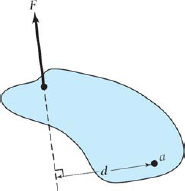3.6. Statics Applications
The following section should be of great interest to students who expect to be involved in structures of any kind, buildings, bridges, trusses, and so forth.
3.6.1. Moments
The moment of a force about some point a (written Ma) is the product of the force F and the perpendicular distance d from the force to the point. The moment of a force is also referred to as torque. In Fig. 3-9 it is
NOTE
![]()
Figure 3.9. FIGURE 3-9

Example 36:The moment of the force in Fig. 3-10 about point a is
|
Figure 3.10. Moment of a force.

3.6.2. Equations of Equilibrium
If the wagon, Fig. 3-11a, is pushed from the left, it will, of course, move to the right. If it does not move, it means there must be an equal force pushing it to the left, Fig. 3-11b. In other words if the wagon does not move, the sum of the horizontal forces acting on the wagon must be zero. When a body is at rest (or moving with a constant velocity) we say that it is in equilibrium.
What we said about horizontal forces also applies to vertical forces, and to moments tending to rotate the body. These are formally stated as the equations of equilibrium. For a body in equilibrium, ...
Get Technical Mathematics, Sixth Edition now with the O’Reilly learning platform.
O’Reilly members experience books, live events, courses curated by job role, and more from O’Reilly and nearly 200 top publishers.

